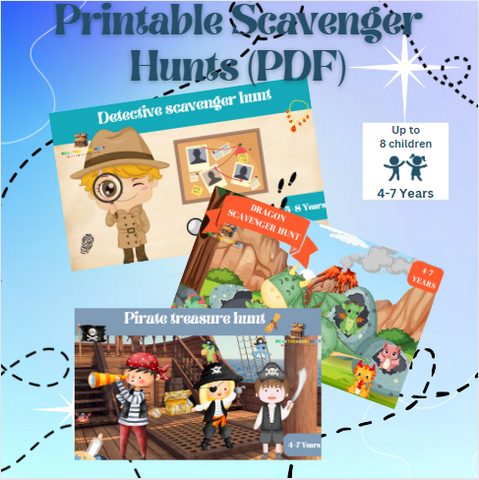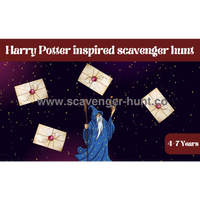🙌Crafting Memorable Adventures: How to Organize the Perfect Treasure Hunt Party for Young Explorers
Embarking on the journey of planning a treasure hunt party intertwined with a scavenger hunt presents a unique blend of excitement, learning, and adventure, specifically tailored for children aged between 4 and 12. This festive gathering is not just a party; it's a meticulously orchestrated event that promises laughter, joy, and the thrill of discovery, designed to captivate the vivid imaginations of young minds. By weaving together creativity, strategic thinking, and physical activity, a treasure hunt party offers an unparalleled experience that enriches the mental and physical prowess of children, while fostering teamwork and problem-solving skills. In this guide, we will navigate through the essential steps and innovative ideas to create an unforgettable scavenger hunt that will be the talk of the town, ensuring a magical experience for both the young adventurers and their guides.

Setting the Stage for Adventure
Crafting the Perfect Scavenger Hunt Theme
Every memorable treasure hunt party begins with a captivating theme. Whether it's pirates searching for hidden gold, detectives solving mysteries, or explorers discovering ancient civilizations, the theme sets the tone for the entire adventure. Key considerations include:
-
Choosing a theme that resonates with the interests of the birthday child and their guests.
-
Creating immersive invitations that hint at the adventure ahead.
-
Decorating the venue to reflect the chosen theme, transforming it into a world of wonder.
The initiation of any unforgettable treasure hunt party pivots around the selection of a compelling theme, which acts as the cornerstone of the entire escapade. This theme not only serves to intrigue and engage the young participants but also to seamlessly integrate the elements of the hunt from start to finish. The meticulous crafting of this thematic foundation is essential in transforming a simple gathering into an extraordinary adventure. Here, we delve into the critical aspects of choosing a theme, designing invitations, and decorating the venue to ensure a fully immersive experience.
Choosing a Theme That Resonates
Selecting the right theme is paramount. It should not only capture the imagination of the birthday child but also appeal to the wider audience of their guests. This decision should consider the interests, age group, and preferences of the participants. Themes like pirates in search of hidden treasures, detectives on the trail of a mystery, or explorers uncovering the secrets of ancient civilizations can spark excitement and anticipation. The chosen theme should be broad enough to allow for creative clues and challenges, yet specific enough to guide the decoration and activities of the party.
To ensure the theme resonates, consider involving the birthday child in the selection process. This could involve a discussion about their current interests or favorite stories and characters. By doing so, you not only tailor the party to their preferences but also engage them in the anticipation of the event.
Crafting Immersive Invitations
The adventure begins long before the actual party, starting with the invitations. These should not be mere requests for attendance but the first clue in the scavenger hunt, setting the tone for the adventure ahead. Invitations designed to match the theme can significantly heighten the excitement and curiosity of the invitees. For a pirate-themed party, for instance, invitations might take the form of aged treasure maps, rolled up and tied with a ribbon, hinting at the quest for hidden gold. For a detective theme, you might create "case files" that include a mysterious letter inviting the children to solve a captivating mystery.
These themed invitations serve a dual purpose: they inform guests about the party details and immerse them into the party's world, building anticipation and excitement for the adventure that awaits.
Decorating the Venue to Reflect the Chosen Theme
The transformation of the party venue into a thematic wonderland is the final step in setting the stage for your adventure. Effective decoration goes beyond mere aesthetics; it's about creating an environment that transports the children into the heart of the adventure. This requires attention to detail and creativity, ensuring every element of the party space contributes to the immersive experience.
For a pirate-themed party, the venue might be adorned with flags, treasure chests, and artificial palm trees, transforming it into a deserted island. A detective-themed party could turn the space into a crime scene or detective's office, with magnifying glasses, footprints, and mystery envelopes scattered around. Explorers discovering ancient civilizations might find themselves in a venue decorated like a jungle or ancient ruins, complete with vines, hieroglyphics, and hidden artifacts.
Incorporating interactive elements into the decorations can further enhance the experience. For instance, a hidden compartment within a decorative artifact could hold the next clue, or a "magical" door could serve as the gateway to the next phase of the adventure. The key is to create an environment that is not only visually captivating but also engaging and conducive to the treasure hunt activities planned.
In conclusion, setting the stage for a treasure hunt party involves much more than just picking a theme; it's about creating a cohesive, immersive experience that begins with the first hint of the party and carries through to the final treasure discovery. By carefully selecting a theme that resonates, crafting immersive invitations, and transforming the venue into a thematic wonderland, you lay the groundwork for an adventure that will captivate and delight young explorers, making the treasure hunt party an unforgettable experience.


Designing the Hunt
Constructing Clues and Challenges
The heart of a scavenger hunt lies in its clues and challenges. They should be age-appropriate, engaging, and cleverly tied to the theme. Strategies include:
-
Crafting clues that range in difficulty, catering to the diverse age group present.
-
Incorporating puzzles, riddles, and physical tasks to keep the participants engaged and moving.
-
Ensuring safety and inclusivity in every aspect of the hunt.
The essence of a memorable scavenger hunt party is encapsulated in the cleverness and creativity of its clues and challenges. These elements are the gears that drive the adventure, requiring thought, teamwork, and physical activity. The design of these components needs to be meticulous, ensuring they are age-appropriate, stimulating, and seamlessly integrated with the party's theme. This chapter explores the intricacies of crafting diverse clues, incorporating a variety of puzzles and tasks, and prioritizing safety and inclusivity throughout the hunt.
Crafting Clues of Varied Difficulty
To cater to a mixed-age group, clues must be designed with varying levels of difficulty. This ensures that every child, regardless of age or ability, can contribute to solving the puzzles and feel a sense of achievement. The clues should be imaginative and tie back to the theme of the party. For example, in a pirate-themed scavenger hunt, clues might range from simple rhymes that younger children can decipher to complex ciphers that older participants can decode.
One effective approach is to use a tiered clue system, where solving one clue leads to another. Starting with simpler clues helps build confidence among the younger adventurers, gradually increasing in complexity to keep older participants engaged. This method also encourages teamwork, as children may need to pool their knowledge and skills to solve the more challenging puzzles.
Incorporating Puzzles, Riddles, and Physical Tasks
A dynamic scavenger hunt intersperses mental challenges with physical activities. Puzzles and riddles stimulate the mind, while physical tasks encourage movement, making the adventure both intellectually and physically engaging. Integrating these elements requires creativity and an understanding of the children's abilities.
Puzzles can include jigsaw pieces scattered throughout the venue that, when assembled, reveal the next clue. Riddles should be thematic and age-appropriate, teasing the brain but not frustrating the participants. Physical tasks might involve hopping from one point to another following a "lava flow" or crawling under "spider webs" made of string. These activities not only add excitement but also help burn off the excess energy of the young participants.
Ensuring Safety and Inclusivity
The paramount concern in designing clues and challenges is the safety and inclusivity of all participants. Every aspect of the hunt should be accessible to children of all abilities, ensuring no one feels left out. Physical tasks, in particular, need to be designed with safety in mind, avoiding any risk of injury.
Inclusivity also means considering the interests and abilities of both boys and girls, ensuring that the tasks and themes are not gender-biased. Clues should be placed within safe reach of the youngest participants and in locations where children are unlikely to encounter hazards. Additionally, the hunt should be structured so that every child can contribute, regardless of their physical ability or intellectual prowess.
Safety can also be enhanced through clear instructions and supervision. Children should be briefed on the rules and boundaries of the hunt, with adults or older children stationed at key points to offer guidance and ensure that the adventure remains fun and safe for everyone.
Conclusion
The construction of clues and challenges is a delicate balance between creativity, inclusivity, and safety. By carefully designing puzzles that stimulate the mind, incorporating physical tasks that encourage active participation, and ensuring that the hunt is accessible and safe for all, organizers can create a scavenger hunt that is not only enjoyable but also memorable. The success of a scavenger hunt lies in the joy and satisfaction of the participants, achieved through well-thought-out challenges that engage and delight children of all ages.


Preparing the Treasure
Selecting Rewards that Spark Joy
The treasure at the end of the hunt is as crucial as the journey itself. It's not just about the physical reward but the joy of discovery and achievement. Ideas for treasures include:
-
Themed goodies that match the party's motif.
-
Educational toys or books that encourage learning beyond the party.
-
Customized keepsakes that remind participants of their adventure.
The climax of a scavenger hunt party is the discovery of the treasure. This moment is the culmination of all the anticipation, effort, and teamwork that the participants have put into the adventure. It's a symbolic reward that transcends the value of the items themselves, embodying the joy of discovery and the sense of achievement. Thus, selecting the right treasures is essential to ensure they resonate with the theme, offer value beyond the party, and leave a lasting memory of the adventure. This chapter delves into how to choose themed goodies, educational rewards, and personalized keepsakes that collectively create a treasure trove that truly sparkles with joy.
Themed Goodies that Enhance the Party's Motif
The treasure should reflect the essence of the party's theme, adding an extra layer of excitement as the chest is opened. For a pirate-themed adventure, the treasure might include gold coin chocolates, eye patches, and miniature telescopes. For a detective-themed hunt, it could contain magnifying glasses, detective badges, and notebooks for jotting down clues. These themed goodies not only serve as rewards but also as mementos that reinforce the day's experiences.
When selecting themed treasures, consider items that have a play value beyond the party, encouraging imaginative play that extends the adventure into the children's daily lives. This not only enhances the value of the treasure but also prolongs the joy and memories associated with the party.
Educational Toys or Books that Encourage Learning
Incorporating educational elements into the treasure can add a layer of value to the rewards, offering benefits that extend beyond the immediate excitement. Books related to the party's theme can open new avenues of exploration and learning, whether it's a story about pirates, a book on detective work, or an encyclopedia on ancient civilizations. Educational toys that align with the theme can also stimulate curiosity and learning, such as puzzles that teach problem-solving skills or kits that introduce basic principles of science and exploration.
Selecting educational treasures is an opportunity to reinforce the notion that learning and adventure go hand in hand, encouraging children to see discovery as both fun and enriching. This approach not only rewards the participants for their efforts but also supports their intellectual growth and curiosity.
Customized Keepsakes that Remind Participants of Their Adventure
Personalized keepsakes are a powerful way to ensure the memories of the adventure last long after the party has ended. These can range from customized medals or certificates of achievement for each participant to photo frames that can hold a picture from the day. Another idea is to provide each child with a small "adventure kit" that they can take home, including items such as a compass, a notepad for their discoveries, and a token that represents the day's journey.
These keepsakes serve as tangible reminders of the adventure, the challenges overcome, and the friendships forged along the way. They transform the treasure into something deeply personal, reinforcing the sense of achievement and the bond between the participants.
Conclusion
The treasure at the end of a scavenger hunt encapsulates the essence of the adventure, rewarding the participants not just with items of value but with memories that last a lifetime. By carefully selecting themed goodies, incorporating educational toys or books, and providing personalized keepsakes, the treasure becomes a chest full of joy, learning, and lasting significance. This thoughtful approach to selecting the rewards ensures that the treasure truly reflects the spirit of discovery and achievement that lies at the heart of every scavenger hunt party.


Engaging the Young Adventurers
Roles and Responsibilities
A successful treasure hunt requires active participation and enthusiasm from the kids. Assigning roles such as leaders, navigators, or puzzle masters can:
-
Enhance teamwork and collaboration among children.
-
Foster leadership and communication skills.
-
Ensure every child feels important and involved in the adventure.
A treasure hunt's vibrancy and success hinge significantly on the active engagement and participation of its young adventurers. By assigning specific roles and responsibilities to the children, you not only enhance the immersive experience of the hunt but also promote valuable life skills such as teamwork, leadership, and effective communication. This chapter delves into the strategies for assigning roles, the benefits of doing so, and how these roles can be tailored to foster an inclusive and collaborative environment, ensuring every participant feels valued and integral to the quest.
Assigning Roles to Promote Teamwork
The first step in engaging the participants is to divide them into teams or groups, depending on the size of the party, and then assign each child a role within their group. These roles can include leaders, who will guide their team through the hunt; navigators, responsible for interpreting maps and directions; and puzzle masters, who will take the lead in solving riddles and puzzles. Assigning these roles does more than just organize the group; it encourages children to work together, leveraging their unique strengths and abilities to achieve a common goal.
Teamwork is fostered as children learn to listen to their leaders, follow the navigators' directions, and collaborate to solve the puzzles presented by the hunt. This cooperative spirit not only makes the hunt more enjoyable but also teaches children the value of working together, sharing ideas, and supporting each other.
Fostering Leadership and Communication Skills
Through the assignment of roles, children are given the opportunity to step into leadership positions, often for the first time. Leaders are tasked with making decisions for the team, motivating their peers, and ensuring that every team member's voice is heard. This responsibility nurtures leadership qualities, including decisiveness, empathy, and the ability to inspire and motivate others.
Similarly, navigators and puzzle masters must communicate effectively with their team, explaining their thinking processes and strategies for finding the next clue or solving a puzzle. This enhances their verbal communication skills, teaching them how to express ideas clearly and listen to feedback from their team members.
Ensuring Inclusivity and Participation
An essential aspect of assigning roles is ensuring that every child feels important and involved in the adventure. This involves recognizing the diverse abilities and interests of the participants and tailoring roles to suit these differences. For example, a child who may not feel confident in leading can be given the role of a historian, responsible for keeping track of the clues found and puzzles solved. Another child might excel as a cheerleader, tasked with keeping the team's spirits high.
It's important to rotate roles throughout the hunt, giving each child the opportunity to experience different aspects of the game. This not only keeps the adventure fresh and engaging but also allows children to discover new strengths and interests they may not have been aware of.
Conclusion
The assignment of roles within a treasure hunt is a powerful tool for engaging young adventurers, enhancing the experience by promoting teamwork, leadership, and effective communication. By carefully considering the abilities and interests of each participant and ensuring that roles are rotated, organizers can create an inclusive environment where every child feels valued and integral to the quest. This approach not only enriches the treasure hunt itself but also imparts important life skills, making the adventure a memorable and formative experience for all involved.


Capturing the Memories
Documenting the Adventure
Preserving the memories of the day is essential. Suggestions for capturing the moment include:
-
Setting up a photo booth with props related to the theme.
-
Creating a treasure map photo album of the day's journey.
-
Encouraging parents to participate in the photo-taking to get candid shots.
In the whirlwind of excitement that defines a treasure hunt party, the moments of joy, triumph, and camaraderie are fleeting, making it imperative to capture these memories for posterity. The act of documenting the adventure not only allows for reflection and reminiscence but also serves as a tangible connection to the shared experience. This chapter explores innovative and engaging ways to capture the essence of the hunt, ensuring that the memories of the adventure endure long after the day has passed.
Setting Up a Themed Photo Booth
A photo booth, strategically placed within the party venue and stocked with props that align with the hunt's theme, offers a fun and interactive way for participants to immortalize their adventure. Whether it's pirate hats and treasure maps for a pirate quest, detective badges and magnifying glasses for a mystery hunt, or ancient helmets and shields for an exploration of lost civilizations, these props encourage children to immerse themselves in their roles and capture memories in a playful setting.
The backdrop of the photo booth can be crafted to resemble a scene from the adventure, such as a pirate ship, a detective's office, or ancient ruins. This not only enhances the thematic immersion but also provides a dynamic and colorful setting for photos. A simple camera setup, possibly operated by a designated "photographer" (a role that can be rotated among adult supervisors), allows for instant capture of these moments, creating instant keepsakes for the children and their families.
Creating a Treasure Map Photo Album
A creative way to compile the memories of the day is through the creation of a "treasure map" photo album. This unique memento can start with a custom-designed map that outlines the journey taken during the treasure hunt, with specific landmarks denoting where key events or challenges took place. Photos capturing these moments can be associated with their corresponding locations on the map, creating a visual and narrative journey through the day's adventures.
This album can be designed as a group activity towards the end of the party, allowing children to contribute by placing photos, decorating pages, and adding personal notes or drawings. Alternatively, it can be a post-event project, assembled by the organizers and then shared with the participants and their families as a surprise keepsake.
Encouraging Parental Participation in Photo-Taking
While the organization and execution of the treasure hunt are primarily the domain of the party planners, inviting parents to participate in the documentation process can enrich the collection of memories. Parents, equipped with their own cameras or smartphones, are often able to capture candid moments that a more formal setup might miss—be it a burst of laughter, a look of concentration, or a spontaneous act of teamwork.
To facilitate this, parents can be encouraged to adopt the role of "adventure photographers," tasked with capturing the essence of the hunt from their unique perspectives. This not only engages them in the event but also ensures a diverse array of photos, showcasing the adventure through multiple lenses. After the event, a shared digital album or social media group can be created to compile these photos, allowing all participants and their families to contribute and share in the memories.
Conclusion
Documenting the adventure of a treasure hunt party is a crucial element in extending the life of the experience beyond the actual event. Through thematic photo booths, creative photo albums, and the active participation of parents in the photo-taking process, the memories of the day can be preserved and cherished. These captured moments serve as a bridge back to the joy, excitement, and camaraderie of the hunt, allowing participants to relive the adventure and share it with others for years to come.


Scavenger Hunt Invitations: Your Adventure Begins Here
The anticipation and excitement for a scavenger hunt party begin with the invitation. A well-crafted invitation not only serves as a call to adventure but also sets the tone for the entire event. It's the first glimpse into the theme and the excitement that awaits, making it a crucial element in the buildup to the treasure hunt. This chapter will guide you through creating engaging, thematic scavenger hunt invitations that captivate and thrill your young adventurers from the moment they receive them.
Crafting the Perfect Invitation
Theme Integration: The invitation should be a reflection of the party's theme, offering a sneak peek into the world the children will be stepping into. For a pirate-themed party, consider using aged paper, rolled up like a scroll, complete with a pirate map and a 'X marks the spot' where the party will be held. For a detective theme, an invitation styled as a top-secret dossier or a mysterious letter that hints at a case to be solved can intrigue and excite the invitees.
Personalization: Adding a personal touch to each invitation makes the recipient feel special and valued. This could be as simple as handwriting each child's name or incorporating a personal message that speaks directly to them, inviting them on the upcoming adventure. Personalization increases the invitation's impact, ensuring that each child is eagerly looking forward to the event.
Interactive Elements: An invitation becomes even more engaging when it includes interactive elements. This could be a small puzzle or riddle that needs to be solved to reveal the party details or a map that leads to a hidden message about the party. Such interactive invitations not only serve as a fun prelude to the scavenger hunt but also get the children's minds engaged and excited about the challenges that lie ahead.
Design and Delivery
Design: The design of the invitation should be visually appealing and aligned with the party's theme. Use vibrant colors, thematic illustrations, and creative fonts to capture the essence of the adventure. For added authenticity, consider using materials or textures that complement the theme, such as parchment paper for a treasure hunt or glossy black cardstock for a spy-themed party.
Delivery: The delivery of the invitation can be an adventure in itself. Rather than simply mailing the invitations, consider delivering them in a way that aligns with the party's theme. For instance, invitations for a pirate party could be delivered inside small bottles. For a mystery-themed hunt, you might deliver the invitations at night, marked as "confidential" to add to the intrigue. Such delivery methods amplify the excitement and set the stage for the adventure that awaits.
Including Essential Information
While creativity is key, it's essential that the invitation contains all the necessary party information:
- Date and time of the party
- Venue details, possibly hidden within a puzzle or riddle
- Theme-specific attire or items the children are encouraged to bring
- RSVP instructions, possibly including a thematic element (e.g., "Send a carrier pigeon to..." or "Decode this message to RSVP")
Conclusion
The invitation is more than just a notice; it's the beginning of your scavenger hunt adventure. By integrating the theme, personalizing the message, incorporating interactive elements, and ensuring the design and delivery are engaging, you set the tone for an unforgettable experience. The anticipation built by a creatively crafted invitation can elevate the excitement for the scavenger hunt, ensuring that the children are buzzing with excitement long before the party begins.


Western Scavenger Hunt for Kids: Crafting Enthralling Clues
Embarking on a Western-themed scavenger hunt catapults young adventurers into the heart of the Wild West, where cowboys, horses, and the quest for hidden treasures reign supreme. This chapter is dedicated to guiding you through the creation of enthralling clues that not only captivate the imagination of young participants but also immerse them in an adventurous quest through the old frontier. Crafting clues for a Western scavenger hunt involves a mix of creativity, theme integration, and age-appropriate challenges that together ensure an engaging and memorable experience for kids.
Setting the Scene
Begin by setting the scene for your young cowboys and cowgirls with an opening narrative or scene that introduces them to the world they're about to explore. This could be a tale of a legendary outlaw's hidden treasure, a map that's been torn into pieces, or a quest to save the town from a notorious bandit. The story sets the tone and gives context to the clues and challenges ahead.
Clue Design: A Blend of the Old West
Rhyming Riddles: Rhymes and riddles are classic elements of scavenger hunts that can be tailored to the Western theme. For example:
"In the place where horses rest,
Find the next clue in a chest.
Look near the saddle, but don't be misled,
The golden horseshoe lies ahead."
This clue leads the adventurers to a barn or stable area, where they'll find their next hint or item.
Map Fragments: Utilize aged paper to create map fragments that, when pieced together, reveal the location of the "hidden treasure" or next clue. Each piece can be found at the end of different challenges, encouraging teamwork and problem-solving.
Historical Figures and Events: Incorporate educational elements by using famous Western figures or events as part of your clues. For example, a clue could lead to a book about Annie Oakley or a poster of Buffalo Bill, each containing the next hint.
Incorporating Physical Challenges: To keep the adventurers moving and add excitement, include physical challenges themed around cowboy tasks. For instance:
-
Lasso Challenge: Set up a roping station where kids must lasso a "steer" (this could be a bale of hay with steer horns) to receive their next clue.
-
Gold Panning: Create a small sandbox or water trough where kids can pan for "gold nuggets" (painted rocks), one of which is marked with the symbol leading to the next location.
Ensuring Safety and Engagement
While creativity is key, ensuring the safety and engagement of all participants is paramount. Clues and challenges should be designed with the physical abilities and attention spans of the children in mind. Ensure that all activities are supervised, especially those that might involve more complex tasks or props.
Clue Locations: Bringing the West to Life
Choose locations for your clues that evoke the spirit of the Wild West. This could be anything from the local park, transformed into a desert landscape with props and decorations, to your backyard, set up as a cowboy camp. Key locations might include:
-
The Sheriff's Office: A clue hidden inside a jail cell or under the sheriff's desk.
-
The Saloon: A puzzle or riddle found behind the bar or under a cowboy hat.
-
The General Store: A scavenger list of items to find that were common in the old West, like lanterns, horseshoes, or bandanas.
Conclusion
Creating clues for a Western scavenger hunt for kids offers a unique opportunity to blend education with entertainment, immersing children in the adventurous spirit of the Wild West while challenging their minds and bodies. By carefully crafting each clue to fit the theme, incorporating physical and mental challenges, and ensuring the journey is safe and engaging, you set the stage for an unforgettable adventure that young cowboys and cowgirls will talk about for years to come. Remember, the true treasure lies not just in the hunt's conclusion but in the joy and camaraderie experienced along the way.


Frequently Asked Questions
Q1: How can I ensure the scavenger hunt is suitable for children of all ages?
-
A1: Tailor the clues and challenges to be inclusive, offering various difficulty levels and types of tasks that cater to both younger and older participants.
Q2: What are some budget-friendly treasure ideas?
-
A2: Consider homemade treasures, such as themed crafts or baked goods. Small, thematic toys bought in bulk can also be cost-effective.
Q3: How long should the scavenger hunt last?
-
A3: Aim for 1-2 hours, depending on the children's ages and attention spans. This duration keeps the energy high and prevents fatigue.
Q4: How can I make the scavenger hunt educational?
-
A4: Incorporate puzzles and challenges that require critical thinking, problem-solving, or learning about history, science, or literature related to the theme.
Q5: What if the weather is bad on the day of the outdoor scavenger hunt?
-
A5: Have a backup plan for an indoor hunt. Use your home or a rented space to create an equally thrilling adventure with indoor-friendly clues and challenges.
Conclusion
Organizing a treasure hunt party with a scavenger hunt for kids is not just about celebrating a special occasion; it's about crafting an enriching experience that stimulates creativity, encourages physical activity, and nurtures critical thinking skills. By following the steps outlined in this guide, you can create an event that transcends the ordinary, fostering unforgettable memories and lifelong skills. Remember, the ultimate treasure is the joy and laughter shared among friends and family, making every scavenger hunt a priceless adventure.
Discover our Complete Scavenger Hunts Collection.










































